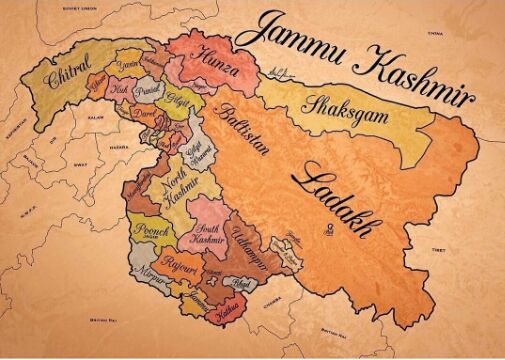The Kashmir 'kingdom'?
The diverse discourse around Jammu and Kashmir is historically deep-rooted and had many parallels along the nature and conduct of contemporary Hyderabad

The challenge in writing about Jammu & Kashmir is not the shortage of material or sources; it is about sifting the grain from the chaff — for so much has been written about the state, from so many different perspectives, and so many times that almost everything that one says is going to be con-tested. It includes the '&'. Many people believe that Jammu & Kashmir became one administrative unit only after the Anglo-Sikh war of 1846. Prior to this, both Jammu and Kashmir had their own independent existence. One must also note that the name which the state gave to itself was Riyasat e Jammu wa Kashmir wa Ladakh wa Tibet ha (kingdom of Jammu, Kashmir, Ladakh and Tibet). It is also true that the greatest focus and contestation has been on the Kashmir valley, and other regions, including Jammu, have not had a fair share of discourse around them. The views, concerns and interests of people inhabiting frontier regions — Ladakh, Chitral, Gilgit, Baltistan and Tibet — have been peripheral to the discourse.
If we were to talk about this physically contiguous region, we will have to start with the oldest extant calendar anywhere in the world — the Saptarishi calendar which is now in its 5097th edition! As per 'Rajatarangini' — a history of Kashmir by Kalhana (12th CE) — Kashmir derives her name from Rishi Kashyap who established a vale by creating 12 streams (Varaha Mula, now Baramulla). The settlement was called Kashyap Pura and was identified as Kasperia by Ptolemy, Kaspatyros by Herodotus and Kaspapyros by Hecacateus and Stephanus of the Byzantium. Etymologically, Jammu is derived from Jambupura, the settlement on the banks of river Tawi established by Raja Jambulochan in the 14th BCE, or perhaps earlier from Jambudweep, the continent in which 'Bharat' is situated. Jammu was always with the Dogras, either directly or under the lordship of Delhi or the Suba of Punjab. Kashmir became part of the Mughal Empire under Akbar from 1586, though the Sufi tradition of Islam was brought in by Nund Rishi or Sheikh Noor-ud-Din Noorani two centuries earlier.
In this and the next three columns, we will primarily be concerned with the vain hope of the Maharaja Hari Singh to assert his Independence vis a vis both the dominions (India and Pakistan), his procrastination in signing the Standstill Agreement with India, his inability to build a working relation-ship with the predominantly Muslim population, and his quick capitulation when he was unable to defend his people or his territory against the Kabailis (frontier tribals) with the support of the Pakistani Army.
Parallels can easily be drawn between Hyderabad and J&K – both were 21-gun salute states with a large territory and population. Both refused to sign the Instrument of Accession before 15th August and harboured illusions of sovereignty. Both were amongst the richest of the Indian princes but, at a personal level, both were extremely 'stingy' and were quite parsimonious in their approach to expenditure.
While Nizam had leased out Berar to the British, the Maharaja had leased out Gilgit Baltistan. Both denied representation and participation to the majority populations (Hindus in the case of Hyderabad and Muslims in the case of J&K). Both faced popular movements against their rule (Congress, Arya Samaj and the Communists against the Nizam, and the National Conference and Muslim Conference against the Maharaja). The Press Attaché to Mountbatten Campbell was asked by Mountbatten to visit both the states as his special representative to bring conciliation between the states and the Dominion. Most interestingly, Jinnah was not comfortable either with the Nizam or with Sheikh Abdullah, for he felt that his 'sole spokesman' status could be challenged. In both states, the 'Mulkis' or local residents started an agitation seeking reservation of government jobs for locals. The Congress and the RSS – both wielded considerable influence – though did not have a strong organisational presence. In Hyderabad, they piggybacked on the Arya Samaj, and in J&K, they found their 'soulmate' in Sheikh Abdullah. Both states saw a 'turnover' of the Prime Ministers – as they were responsible only to the whims of the ruler rather than to the popularly elected assembly.
In both situations, the Indian Army was called in to meet the strategic objectives of the Indian state. However, while they completed the task in Hyderabad, in J&K, they were hamstrung on account of Prime Minister Nehru's faith in the UN. Perhaps, having learnt the lessons in J&K in 1947/48, India was better prepared to accomplish all the goals of Mission Polo. The majority population was in favour of the Dominion of India over Pakistan and that's what made the task for the Army much easier. Both the Nizam and the Maharaja were driven to the wall before they signed the Instrument of Accession. Both became Rajpramukhs in 1950, but thanks to the internationalization of the dispute, J&K got Article 370, and its residents got dual citizenship, and these anomalies continued right up to 2019.
Views expressed are personal



